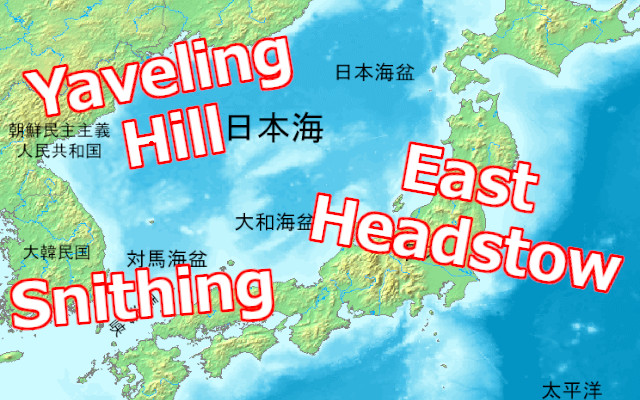
Yeetstead is quite beautiful this time of year.
We’ve seen before the crazy things that can happen when Japan gives kanji-names to foreign countries or when foreigners give kanji-names to themselves.
But what about the reverse? What if someone took the kanji-names of the 47 Japanese prefectures and turned them into English instead?
That’s exactly what Reddit user topherette did, compiling a map of Japan with Anglicized versions of the names of the prefectures, islands, and some cities as well.
And when we say there’s a lot more going on here, we mean it. The map’s creator topherette put a ton of research and careful thought into each of the names. Let’s take a look at a few examples:
- Aomori (青森) turns into Greenwood, which is pretty straightforward. One of the meanings of “ao” is “green” and “mori” means “woods/forest.” Simple enough.
- Niigata (新潟) turns into Newpool, which is great. “Nii” means “new” and “gata” means “lagoon,” so “pool” is a great choice, making it sound like Liverpool.
- Tokyo (東京) turns into East Headstow, which is an absolute delight. “To” meaning “east” is pretty simple, but “kyo” means “capital,” though the author wasn’t satisfied with just that. To make it really feel English, they opted for Anglo-Saxon words whenever possible, in this case “heáfod-stów” (meaning “capital”).
Those are cool but mostly self-explanatory. Let’s take a look at a few more advanced ones:
- Akita (秋田) turning into Sadfield might not make sense right away if you can read Japanese. Doesn’t “aki” mean “autumn?” Shouldn’t it be “Autumn Field?” The answer is that the “Aki” in Akita used to be written with a different kanji, in this case 飽 meaning “bored/tired/sad.” No wonder the people living there changed the name!
- Shizuoka (静岡) turning into Netherhill might also be confusing, since “shizu” means “quiet.” Shouldn’t it be “Silent Hill?” But again the answer is that Shizuoka used to be written differently, using 賤 meaning “despite/poverty/low.” The word “nether” is a great word to combine them together, reminiscent of “nether regions.” Again, a solid name change.
- Fukui (福井) turning into Yeetwell is both hilarious and awesome. Similar to the last two, the “fuku” in modern-day “Fukui” means “fortune/happiness,” but it used to be written with 脹 meaning “bulge/swell.” The author used the Old English word “geotan” meaning “to pour/gush” which evolved linguistically into “yeet.” And “i” just means “well/water hole.”
And then there’s the names of Japan’s four islands themselves!
- Honshu (本州 meaning “main province”) becoming Mainland makes sense.
- Kyushu (九州 meaning “nine provinces”) as Nineshire is absolutely adorable.
- Shikoku (四国 meaning “four countries”) as Fourland sounds like the setting for an English fairytale.
- Hokkaido (北海道 meaning “northern sea road”) as North Key Way has one of the most interesting reasons behind it. While “north” and “way” are direct translations, the middle “kai” didn’t originally actually mean “sea,” it was the word that the native Ainu people used for the land. The Japanese people simply used “sea” because it was pronounced “kai” too and thus “Hokkaido” was born. Here, similarly, the author has chosen an English word (“key”) similar to the original Ainu (“kai”).
- Oh, and don’t forget that Japan (日本 meaning “sun origin”) is now Sunwell too!
Of course as topherette admitted, this kind of thing is not an exact science, and many locations have different competing etymologies. But it’s still a lot of fun to look at, and be sure to check out the original Reddit thread for some more detailed explanations, as well as the rest of the Toponomy subreddit for more cool “translated” maps.
And if you want to take a look at some great, professional examples of translating Japanese names to English, see what you think of the top 5 best Pokémon name translations too.
Source: Reddit/topherette
Top image: Wikimedia Commons/DEMIS World Map Server, Artanisen (Edited by SoraNews24)
Insert image: Reddit/topherette
● Want to hear about SoraNews24’s latest articles as soon as they’re published? Follow us on Facebook and Twitter!

 Brain Gymnastics Quiz: Move one matchstick to create the name of a Japanese Prefecture
Brain Gymnastics Quiz: Move one matchstick to create the name of a Japanese Prefecture Japan would like to remind you that “emoji” has nothing to do with “emotion”
Japan would like to remind you that “emoji” has nothing to do with “emotion” W.T.F. Japan: Top 5 most insane kanji place names in Japan【Weird Top Five】
W.T.F. Japan: Top 5 most insane kanji place names in Japan【Weird Top Five】 Why Does Engrish Happen in Japan? Part 2: Please refrain from using the bathroom alone
Why Does Engrish Happen in Japan? Part 2: Please refrain from using the bathroom alone Japan’s Kinki University decides to change its naughty-sounding name
Japan’s Kinki University decides to change its naughty-sounding name Disillusionment at Tsukiji’s tourist-target prices led us to a great ramen restaurant in Tokyo
Disillusionment at Tsukiji’s tourist-target prices led us to a great ramen restaurant in Tokyo Starbucks Japan releases new zodiac chilled cup drink for 2026
Starbucks Japan releases new zodiac chilled cup drink for 2026 More Than a Capsule Stay: Why Solo Travelers Choose “global cabin Yokohama Chinatown”
More Than a Capsule Stay: Why Solo Travelers Choose “global cabin Yokohama Chinatown” How hard is it to break Japanese tiles like a karate pro?
How hard is it to break Japanese tiles like a karate pro? Stay at a Japanese capsule hotel in Tokyo for less than US$20 a night
Stay at a Japanese capsule hotel in Tokyo for less than US$20 a night Create your own Sailor Moon heroines with the awesome Sailor Senshi Maker
Create your own Sailor Moon heroines with the awesome Sailor Senshi Maker Our reporter tries amemonaka, the traditional sweet from Niigata Prefecture
Our reporter tries amemonaka, the traditional sweet from Niigata Prefecture Step into Japanese culture with Converse’s new Japan-exclusive shoes featuring gods, sushi style
Step into Japanese culture with Converse’s new Japan-exclusive shoes featuring gods, sushi style A Japanese dating app matched our bachelorette with a Buddhist monk, and she learned some things
A Japanese dating app matched our bachelorette with a Buddhist monk, and she learned some things Burgers soaked in a plate of hot cheese served at American Diner Andra in Tokyo
Burgers soaked in a plate of hot cheese served at American Diner Andra in Tokyo 7-Eleven Japan starts new temporary luggage storage service in over 300 branches
7-Eleven Japan starts new temporary luggage storage service in over 300 branches Starbucks teams up with 166-year-old Kyoto doll maker for Year of the Horse decorations【Photos】
Starbucks teams up with 166-year-old Kyoto doll maker for Year of the Horse decorations【Photos】 Tokyo’s Tsukiji sushi neighborhood asks tour groups to stay away for the rest of the month
Tokyo’s Tsukiji sushi neighborhood asks tour groups to stay away for the rest of the month Street Fighter Hadouken Churros to be launched and eaten in Tokyo, Okami pudding on offer too
Street Fighter Hadouken Churros to be launched and eaten in Tokyo, Okami pudding on offer too Japanese avoiding domestic travel as foreign tourists increase, possibly creating vicious cycle
Japanese avoiding domestic travel as foreign tourists increase, possibly creating vicious cycle Japanese woman mistaken for bear
Japanese woman mistaken for bear Return of Totoro sequel short anime announced for Ghibli Park
Return of Totoro sequel short anime announced for Ghibli Park Is this the most relaxing Starbucks in Japan?
Is this the most relaxing Starbucks in Japan? Starbucks on a Shinkansen bullet train platform: 6 tips for using the automated store in Japan
Starbucks on a Shinkansen bullet train platform: 6 tips for using the automated store in Japan More Shinkansen trains being added to Japan’s “golden route” to meet traveler demand
More Shinkansen trains being added to Japan’s “golden route” to meet traveler demand Japan’s human washing machines will go on sale to general public, demos to be held in Tokyo
Japan’s human washing machines will go on sale to general public, demos to be held in Tokyo Starbucks Japan unveils new Christmas goods and a rhinestone tumbler that costs 19,500 yen
Starbucks Japan unveils new Christmas goods and a rhinestone tumbler that costs 19,500 yen Japanese train company is letting fans buy its actual ticket gates for their homes
Japanese train company is letting fans buy its actual ticket gates for their homes Is China’s don’t-go-to-Japan warning affecting tourist crowds in Tokyo’s Asakusa neighborhood?
Is China’s don’t-go-to-Japan warning affecting tourist crowds in Tokyo’s Asakusa neighborhood? The 10 best day trips from downtown Tokyo【Survey】
The 10 best day trips from downtown Tokyo【Survey】 Tokyo considering law requiring more trash cans following litter increase in heavily touristed area
Tokyo considering law requiring more trash cans following litter increase in heavily touristed area Nintendo’s Kirby now delivering orders at Kura Sushi restaurants, but not in Japan
Nintendo’s Kirby now delivering orders at Kura Sushi restaurants, but not in Japan Survey asks foreign tourists what bothered them in Japan, more than half gave same answer
Survey asks foreign tourists what bothered them in Japan, more than half gave same answer Japan’s deadliest food claims more victims, but why do people keep eating it for New Year’s?
Japan’s deadliest food claims more victims, but why do people keep eating it for New Year’s? We deeply regret going into this tunnel on our walk in the mountains of Japan
We deeply regret going into this tunnel on our walk in the mountains of Japan Studio Ghibli releases Kodama forest spirits from Princess Mononoke to light up your home
Studio Ghibli releases Kodama forest spirits from Princess Mononoke to light up your home Major Japanese hotel chain says reservations via overseas booking sites may not be valid
Major Japanese hotel chain says reservations via overseas booking sites may not be valid Put sesame oil in your coffee? Japanese maker says it’s the best way to start your day【Taste test】
Put sesame oil in your coffee? Japanese maker says it’s the best way to start your day【Taste test】 The top 10 annoying foreign tourist behaviors on trains, as chosen by Japanese people【Survey】
The top 10 annoying foreign tourist behaviors on trains, as chosen by Japanese people【Survey】 No more using real katana for tourism activities, Japan’s National Police Agency says
No more using real katana for tourism activities, Japan’s National Police Agency says Starbucks Japan reveals new sakura drinkware collection, inspired by evening cherry blossoms
Starbucks Japan reveals new sakura drinkware collection, inspired by evening cherry blossoms Japan travel bucket list: top places to visit in each prefecture before you die【Part II】
Japan travel bucket list: top places to visit in each prefecture before you die【Part II】 Meow’s this? 2020’s ranking of the top cat names and breeds in Japan
Meow’s this? 2020’s ranking of the top cat names and breeds in Japan Why Does Engrish Happen in Japan? 30-year-old fart-related signage mistake edition
Why Does Engrish Happen in Japan? 30-year-old fart-related signage mistake edition Japan Bucket List II: 8 places you need to visit to really understand Japan
Japan Bucket List II: 8 places you need to visit to really understand Japan What’s that emoji? Let’s take a look at Japanese culture with these texting emoticons!【Part 1】
What’s that emoji? Let’s take a look at Japanese culture with these texting emoticons!【Part 1】 W.T.F. Japan: One year anniversary special! Top 5 W.T.F. Japan articles 【Weird Top Five】
W.T.F. Japan: One year anniversary special! Top 5 W.T.F. Japan articles 【Weird Top Five】
Leave a Reply